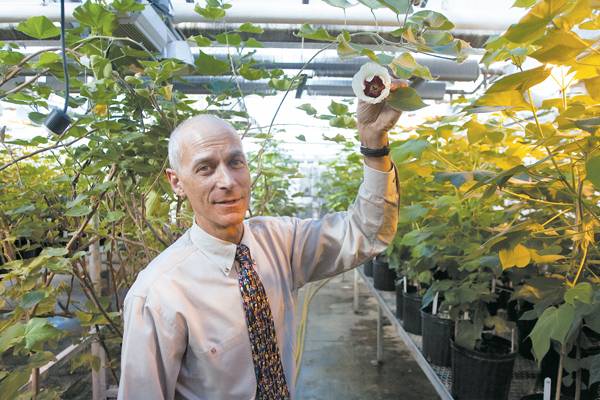ISU professor studies evolution of cotton

Dr. Jonathan Wendel of Iowa State displays the various plants and trees growing in the greenhouse on top of Bessey Hall on Feb. 10, 2010. Photo: Joseph Bauer/Iowa State Daily
March 21, 2016
It’s in clothes, coffee filters, fishnets and more, but over the years, cotton has evolved from its primitive state to what humans know now: white and fluffy.
Jonathan Wendel, professor and chair of the department of ecology, evolution and organismal biology, is doing research on the way cotton has evolved.
Wendel, who was recently featured as a leading researcher by the Crop Science Society of America, does research to discover the history of cotton’s evolution and the way it has continued to evolve.
“The major plants of the world that you see around you and that you see at the grocery store and that you see in pictures of the tropical forest and everything else, those all descend from a common ancestor, probably around 150 million years ago,” Wendel said.
Plants and animals weren’t domesticated until humans arrived around 10,000 years ago, Wendel said. Even the maize (corn) that can be seen everywhere in Iowa is a wild plant domesticated by humans in southwest Mexico.
Wendel uses the lens of archeobotany to explore the history of cotton, using DNA sequencing and the molecular clock to date genes.
Cotton has four different species that were each independently domesticated by ancient cultures, all from different wild species, so four different independent domestications were created.
Wendel said sometime around a million years ago one of the species of cotton that grows in Africa managed to cross the ocean and hybridized with a species in the new world, doubling the chromosomes and creating a new lineage of plants with twice the chromosome number of its ancestors. This makes that domestication of cotton a polyploid, something that Wendel is very interested in.
“In a nutshell, what I’ve been working on is unraveling this marvelous, complex evolutionary history and putting time and dates on it all,” Wendel said.
Wendel became aware of polyploid plants in the mid-1970s and was instantly fascinated by the form of speciation, which is very common in plants.
“Since then it’s just been so much fun,” Wendel said. “I feel like the first person ever to enter a tropical forest. Every rock I pick up there’s a new beast to describe.”
Wendel said he thought it was interesting that all plants that have sustained human life were polyploid at some point in their history.
“I didn’t know that we had researchers here working on things like the evolution of plants,” said Evan Kammermeier, junior in software engineering. “It’s nice to see that we have diverse research at this university.”
Wendel said he believes we’re entering the golden age of biology and that Iowa State is the optimal place to be to study the history of the field.
“Iowa State is one of the centers of the universe in plant genomics and evolutionary genomics,” Wendel said, adding that there is no place he’d rather be.






